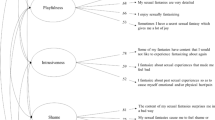Abstract
The Wilson Sex Fantasy Questionnaire (WSFQ; Wilson, 1978) is a 40-item self-report questionnaire that assesses 4 types of sexual fantasies: Exploratory, Intimate, Impersonal, and Sadomasochistic. The goal of the present study was to examine the differences between child molesters (n = 64) and nonsexual offenders (n = 41) on the WSFQ. Comparisons included the four underlying factors, 2 factors associated with the fantasizer's role in the fantasy (active vs. passive), and 2 items most closely related to sexual molestation behavior. Results found that molesters reported higher scores on the Exploratory and Intimate subscales, as well as overall fantasy. Scores on the Impersonal and Sadomasochistic subscales were not significantly different. Molesters also reported higher scores on fantasies where they were the actor, and higher scores on fantasies most closely related to sexual molestation behavior. Subsequent analyses found that both offender groups reported significantly lower levels of fantasies than college comparison subjects and noncriminal sexual deviants. Differences among the 2 study groups are discussed in terms of social and cognitive characteristics of molesters.
Similar content being viewed by others
REFERENCES
Abel, G., & Blanchard, E. (1974). The role of fantasy in the treatment of sexual deviation. Archives of General Psychiatry, 30(4), 467-475.
American Psychiatric Association. (1994). Diagnostic and statistical manual of mental disorders (4th ed.). Washington, DC: Author.
Barbaree, H. E., & Marshall, W. L. (1991). The role of male sexual arousal in rape: Six models. Journal of Consulting and Clinical Psychology, 59(5), 621-630.
Gosselin, C., & Wilson, G. (1980). Sexual variations. London: Faber and Faber.
Hall, G. C. N., & Hirschman, R. (1992). Sexual aggression against children: A conceptual perspective of etiology. Criminal Justice and Behavior, 19(1), 8-23.
Knight, R. A., Warren, J., Reboussin, R., & Soley, B. (1998). Predicting rapist type from crime-scene variables. Criminal Justice and Behavior, 25(1), 46-80.
Langevin, R., Lang, R., & Curnoe, S. (1998). The prevalence of sex offenders with deviant fantasies. Journal of Interpersonal Violence, 13(3), 315-327.
Langevin, R., Wright, P., & Handy, L. (1989). Characteristics of sex offenders who were sexually victimized as children. Annals of Sex Research, 2(3), 227-253.
Laws, D., & Marshall, W. L. (1990). A conditioning theory of the etiology and maintenance of deviant sexual preference and behavior. In W. L. Marshall, D. Laws, & H. E. Barbaree (Eds.), Handbook of sexual assault: Issues, theories, and treatment of the offender (pp. 209-229). New York: Plenum Press.
Leitenberg, H., & Henning, K. (1995). Sexual fantasy. Psychological Bulletin, 117(3), 469-496.
Looman, J. (1995). Sexual fantasies of child molesters. Canadian Journal of Behavioural Science, 27(3), 321-332.
Marshall, W. L. (1996). Assessment, treatment, and theorizing about sex offenders: Developments during the past twenty years and future directions. Criminal Justice and Behavior, 23(1), 162-199.
Marshall, W. L., & Barbaree, H. E. (1990). An integrated theory of sexual offending. In W. L. Marshall, D. R. Laws, & H. E. Barbaree (Eds.), Handbook of sexual assault: Issues, theories, and treatment of the offender (pp. 257-275). New York: Plenum Press.
Marshall, W. L., Barbaree, H. E., & Fernandez, Y. M. (1995). Some aspects of social competence in sexual offenders. Sexual Abuse: A Journal of Research and Treatment, 7(2), 113-127.
Marshall, W. L., Laws, D., & Barbaree, H. E. (1990). Handbook of sexual assault: Issues, theories, and treatment of the offender. New York: Plenum Press.
Nichols, H. R., & Molinder, I. (1984). Multiphasic Sex Inventory Manual. Tacoma, WA: Author.
O'Connell, M. A. (1998). Using polygraph testing to assess deviant sexual history of sex offenders (Doctoral dissertation, University of Washington, 1998). Dissertation Abstracts International, 58, 3023.
O'Donohue, W., Letourneau, E. J., & Dowling, H. (1997). Development and preliminary validation of a paraphilic sexual fantasy questionnaire. Sexual Abuse: A Journal of Research and Treatment, 9(3), 167-178.
Pithers, W. (1990). Relapse prevention with sexual aggression: A method for maintaining therapeutic gain and enhancing external supervision. In W. L. Marshall, D. Laws, & H. E. Barbaree (Eds.), Handbook of sexual assault (pp. 343-360). New York: Plenum Press.
Plaud, J., & Bigwood, S. (1997). A multivariate analysis of the sexual fantasy themes of college men. Journal of Sex and Marital Therapy, 23(3), 221-230.
Proulx, J., Perreault, C., & Quimet, M. (1999). Pathways in the offending process of extrafamilial sexual child molesters. Sexual Abuse: A Journal of Research and Treatment, 11(2), 117-129.
Quinsey, V. L., Harris, G. T., Rice, M. E., & Cormier, C. A. (1998). Violent offenders: Appraising and managing risk. Washington, DC: American Psychological Association.
Rokach, A., Nutbrown, V., & Nexhipi, G. (1988). Content analysis of erotic imagery: Sex offenders and non-sex offenders. International Journal of Offender Therapy and Comparative Criminology, 32(2), 107-122.
Sahota, K., & Chesterman, P. (1998). Mentally ill sex offenders in a regional secure unit II: Cognitions, perceptions, and fantasies. Journal of Forensic Psychiatry, 9(1), 161-172.
Wilson, G. (1978). The secrets of sexual fantasy. London: J. M. Dent & Sons.
Wilson, G. (1988). Measurement of sex fantasy. Sexual and Marital Therapy, 3(1), 45-55.
Wilson, G. (1997). Gender differences in sexual fantasy: An evolutionary analysis. Personality and Individual Differences, 22(1), 27-31.
Author information
Authors and Affiliations
Rights and permissions
About this article
Cite this article
Baumgartner, J.V., Scalora, M.J. & Huss, M.T. Assessment of the Wilson Sex Fantasy Questionnaire Among Child Molesters and Nonsexual Forensic Offenders. Sex Abuse 14, 19–30 (2002). https://doi.org/10.1023/A:1013025410090
Issue Date:
DOI: https://doi.org/10.1023/A:1013025410090




